Home to Large Tea Estates, Assam’s Behali Still Lacks Sufficient Healthcare Facilities
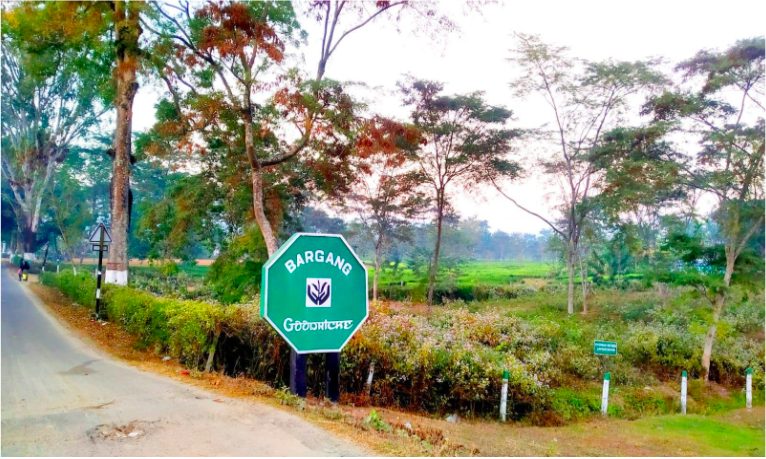
The Bargang Tea Estate in Behali, Assam. This tea garden is owned by Goodricke.
Behali is a significant place in the tea economy of Assam and has a large population of tea workers. But even as the pandemic has been sweeping through the country for nearly two years now, healthcare facilities in Behali remain extremely deficient in meeting even basic needs of patients let alone provide Covid care.
Situated in middle of the state and within the contours of Biswanath district, Behali cradles large tea gardens; in fact, it has the largest tea garden of Assam -- Monabarie Tea Estate. Owned by McLeod Russel and a part of the Williamson Magor group, the Monabarie Tea Estate is claimed to be not only the largest such garden in Assam but also in the world. Behali also has other large tea gardens like Borgang Tea Estate (Owned by Goodricke), Behali Tea Estate (Under Williamson Magor), Kettela Tea Estate, Gingia Tea Estate etc. Along with the big gardens owned and operated by big corporations, Behali also houses numerous small tea growers.
This economy of Behali translates to it housing a majority of Assam’s tea worker community. Originally, adivasis, mostly from Jharkhand and Odisha, were forced to migrate during the colonial period when the British regime expanded their business to establishing tea gardens in Assam. Most of the working community lives in penury even today, with big companies like Williamson Magor and McLeod Russel continuing to profit from their labour. Behali also houses other tribal communities indigenous to Assam and also has a non-tribal Assamese population. However, despite its economic importance, the place still suffers from the absence of healthcare, education or other basic amenities.
Newsclick visited Behali to look at the healthcare facilities both inside the gardens and outside. Inside the garden, the facilities are such that workers have to strive to merely survive. But outside, the government has not made life easy for the destitution striken workers either.
Behali is a development block in Biswanath District, which came into being in 2015 after being separated from Sonitpur district. The district administration web page informs that Biswanath has a population of over six lakh, as per the 2011 Census. It further says that the new district has two sub-divisional civil hospitals and there is no full-fledged civil hospital or district hospital yet.
There are also three model hospitals along with a few Primary Health Centres (PHCs), and over hundred sub centres. Notably, the district hospitals and the model hospitals have the facilities of admitting patients; the other government health structures have the primary facilities, however, some of them only have a meagre capacity to admit patients.
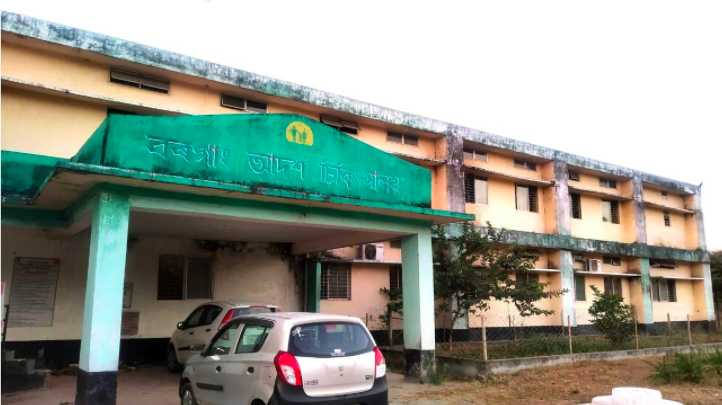
The Borgang Model Hospital in Behali, Assam.
The Borgang Model Hospital in Behali stands adjacent to National Highway 15 that runs through Behali and Biswanath. Upon reaching there at around 3 pm, Newsclick found the hospital wearing a deserted look, which has apparently become a common experience now. Newsclick spoke to Dr Sujit Shandillya, an ayurvedic doctor who was on duty that day, about the shortcomings of the facilities.
Talking about the insufficient number of doctors, which Newsclick witnessed in all other places in Assam, Shandillya said that while being transferred here, some doctors also get their service attached to some other hospitals. “This means that they are posted in this hospital but they serve in a different premise,” he said. Interestingly, this process that has widened the cracks in the health services, is prevalent throughout Assam.
The model hospitals in Assam were started with the aim of providing modern health facilities even to the population in places far from cities. The model hospitals are built with OT (operation theatre) and most are equipped with diagnosis techniques like X-ray, sonography etc. These hospitals are relatively free from other burdens that PHCs have to bear. However, Newsclick’s visits found that despite the infrastructure, the gross insufficiency of manpower could not have served the initial purpose of the model hospitals. Dr Shandillya agreed to this to some extent. The OT and sonography equipment at the model hospital have been non-operational due to the lack of doctors, he said.
The Borgang Model Hospital is 50-bedded. However, in reality, the hospital IPD (In-patient Department) is not fully functional and the biggest reason behind it is the unavailability of a kitchen in the premises, said Dr Shandillya. The model hospital has seven GNM (General Nursing and Midwifery) nurses, he said. There is an ambulance which was provided by an NGO, but even that does not provide regular service. The 108 emergency ambulance service is the sole mode of transferring critical patients to other higher level hospitals.
However, the model hospital was a designated a Covid-19 treatment hospital, and during the peak times, it could admit 40 patients, according to Dr Shandillya. The food then was managed by the district administration and the basic medicines like anti-pyretic and anti-biotic were in abundance during those times. However, there was no Heparin to treat those with blood clots and when asked about Remdesivir, Dr Shandillya could not confirm any information. He told Newsclick that oxygen scarcity was not felt at any point. “The district administration managed doctors from other places to this hospital and there were other CCCs (Covid Care Centres) nearby where some patients could be transferred,” he added.
However, Dr Shandillya shared something very interesting. He said that before this hospital became a Covid-19 hospital or before the arrival of the pandemic, they used to get 200 patients on an average. But now, the number has reduced substantially to only 20-25 patients a day. The main reason behind this, he said, could be the fear among people to get tested for Covid-19.
The majority of the patients that come here belong to the tea working community and one of the most prevalent condition, apart from tuberculosis, is anemia, both among males and females. Dr Shandillya said the strongest possible reason for it could be the lack of nutrition, which is most prevalent in the tea worker population.
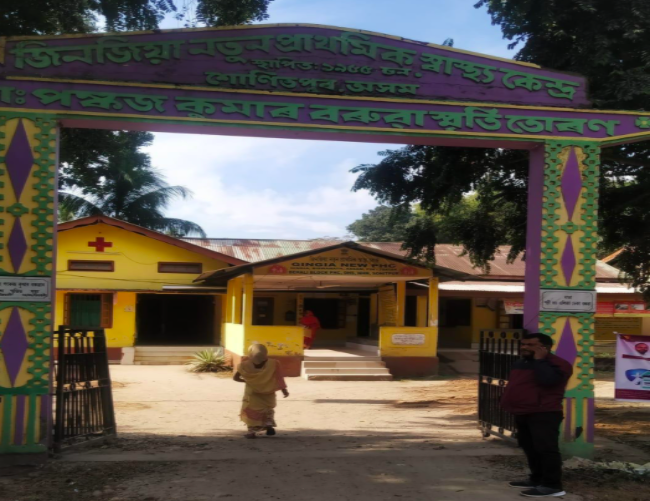
A few kilometres farther from the Borgang Model Hospital is the Gingia PHC. With one doctor (another one attached to the Borgang Model Hospital), two ANM, and two GNM nurses, the PHC has to cater to a population of 56,456, said Dr Babul Keot, who Newsclick met on the day of the visit. Dr Keot said that doctors did not come to join in such an interior PHC and this mounted the crisis here.
The PHC also has to monitor Monabarie and Gingia Tea Estate, especially in supplying medicine under the National Health Mission. “We visit the hospitals in the tea gardens and in some cases they call us,” said Dr Keot.
The Gingia PHC has one ambulance and according to him it is used in severely critical cases. The locality near the PHC has tea working community along with other tribal population. In peak season (summer), the usual number of patients that the doctor has to take care of is around 100 per day. TB, anemia, respiratory tract infection, and elephantiasis were some of the prevalent diseases in the community, Dr Keot explained.
During the peak Covid times, the PHC conducted the targeted testing and there was low to moderate positivity, Dr Keot said. However, they had to transfer the patients to the nearby CCC (the makeshift Covid Care Centres set up in school, college or other such public premises) or to the civil hospital.
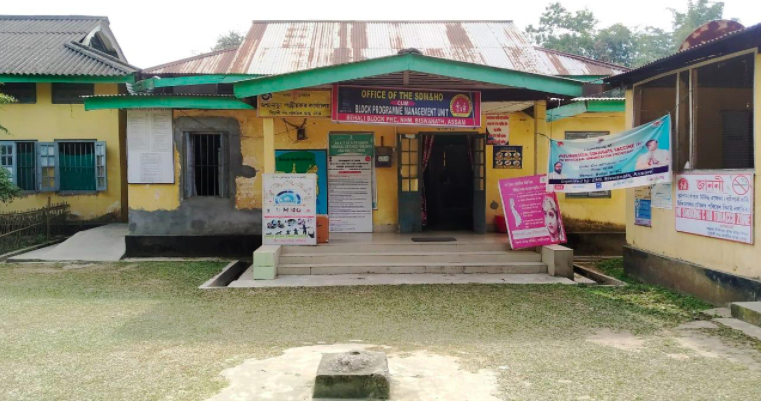
The Behali BPHC (Block PHC) is important in several aspects. This hospital seems to be the busiest one in Behali. When Newsclick spoke to the locals they expressed their preference for BPHC over the model hospital. “This is because of the difference in the availability of medicines and care,” a local said. The BPHC is not easily accessible like the model hospital as one has to travel through villages to reach the hospital premises.
Dr Jogen Chandra Bey, the Sub Divisional Medical and Health Officer (SDM&HO) of BPHC, gave an account of the status of manpower in this important government health set-up. He said posts of two SMOs (Senior Medical Officer, which are doctors) remain vacant along with one ayurvedic doctor. Dr Bey and another doctor from the compulsory rural posting scheme are there at present. The BPHC has 2 ANMs and 4 GNMs. “Under this BPHC come four PHCs, the model hospital and five tea garden hospitals he told Newsclick. “The SDM&HO has to look after the administrative affairs and also the patients. Managing all these with such a minimal strength of doctors put enormous pressure upon us.”
A glimpse of the activities that the Behali BPHC has to conduct at a regular basis is the Directly Observed Therapy/Treatment or DOT for TB, antenatal tests, malaria, HIV, taking care of deliveries and the post mortems. The Behali BPHC is the post-mortem centre of the district and also a Designated Microscopic Centre. The locals consider it as government apathy to run such a busy primary health care centre with high insufficiency of manpower.
Dr Bey said there was no full time doctor for conducting the post mortems and as a result, all the summons from court directly came to him and he had to appear before the court very often. While speaking to Newsclick for around 45 minutes, two summons reached Bey. He said on an average, there would be 25 cases of post-mortems at BPHC and there is only one attached doctor for it. Moreover, without a permanent cleaner, it becomes difficult sometimes to maintain cleanliness, he said.
During peak season (often in summer) the hospital has to attend 150-200 patients daily on an average, Bey said. Alongside, the BPHC has a high rate of institutional deliveries and Bey remembered that once there were nearly 100 deliveries in a month. “Now we have three Health and Wellness Centres specially to look after the deliveries, where community health officers and nurses offer their services,” he said.
Bey also said that there was a high prevalence of TB in the area, especially among the tea garden workers and this pertains to their weak immunity, heavy malnourishment, and poor hygiene conditions. He also remarked that once there had been a huge outbreak of Filariasis in some tea gardens. “In Gingia tea estate, the positivity rate was 50%. In any case, Filariasis is very common in the tea gardens,” Bey added.
The Behali BPHC has a TB unit with one Senior Treatment Supervisor. Speaking to Newsclick, Abhijeet Baruah, the Senior Treatment Supervisor, said that there were 167 TB cases in 2021. However, the lockdowns and the pandemic made it difficult to carry forward the TB surveillance task, he added. The Cartridge Based Nucleic Acid Amplification Test (CBNAAT) for more specification about antibiotic resistant TB strains is also available there, but “for the last six months, there has been no CBNAAT test due to the lack of cartridges,” Baruah said.
Moving northward from the Behali BPHC and into the interior part of Behali, Newsclick reached the Bihmari and Bongaon PHC. This PHC is situated in one of the most interior places and stands amidst rice fields, with a very narrow road leading to the entrance; the road is so narrow that an ambulance would not be able to use it.
The Bihmari PHC was established in 2013 and for years, it lied without function; it was only in 2018 that the PHC has come into operation. Dr. Hirakjyoti Talukdar, is posted there under the compulsory rural posting scheme in the PHC with two nurses and a pharmacists. There is no ambulance, water and electricity supply to the PHC, said Dr. Talukdar. The PHC has to cater approximately a population of 25,000 people and on an average, Dr. Talukdar has to attend about 40 patients, which increase in summers.
Situated several kms away from the main centre of Behali, the PHC has to deal with nearby village population. Dr. Talukdar said that he is putting a lot of efforts to get electricity and water to the PHC as well as to his residence in the vicinity of the health centre.
Dr. Talukdar further said--“Earlier, the medicines supplied to the PHC was managed by the block PHC. Now, I personally prepare the list of medicines that are specifically needed for here and urge at the district level.”
About the prevalence of disease pattern he said that skin diseases like Scabies, Tinea, Eczema, Dermatitis etc. are quite common in the nearby areas. Along with it, TB, malaria and anemia are of high concern. Respiratory Tract Infection, chicken pox, hypertension are also found commonly among the patients-- Dr. Talukdar commented. These are attributable to poor hygiene, lack of awareness and malnutrition, he said.
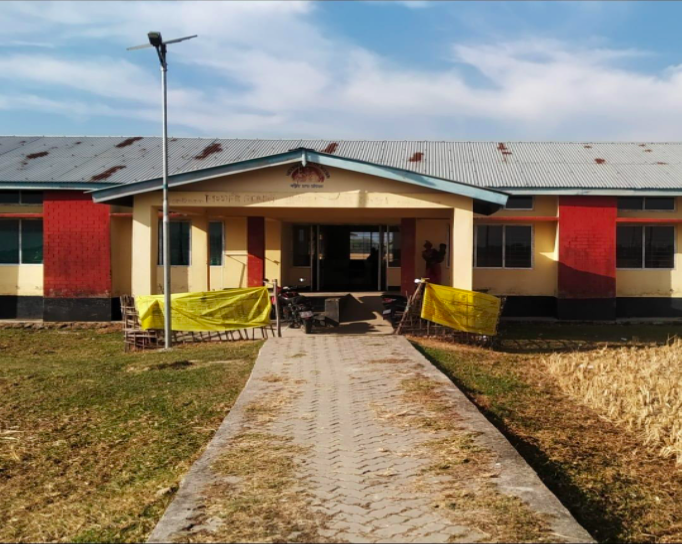
The Bihmari and Bongaon PHC situated amidst a rice field, with a narrow path leading to the building.
The Curious Case of Naharjan Village
While visiting the Bihmari PHC, Newsclick came to know about a village named Naharjan. Now, a part of this village has gone to Arunachal Pradesh. Situated at the fringe of the Behali reserve forest, the village borders Arunachal Pradesh. “People there had no access to electricity, water, transport, or healthcare. Moreover, the Assam police and forest department would often harass the villagers. People residing in a part of Naharjan changed their voting centres to Arunachal Pradesh, and now, they write their address as of Arunachal Pradesh. They get electricity, water, health and school after they have changed their address,” said Pranjal Kutumb, a resident of Naharjan village (on Assam side), to Newsclick over the phone.
Meanwhile, the villagers on the Assam side are yet to see better times. “The villagers who continue to live on Assam side often have to meet with confrontation from police and forest department. They are deprived of all the basic amenities,” Bibek Das, leader of the Communist Part of India (Marxist Leninist), told Newsclick.
Before the division, Naharjan was also a struggle ground. Das explained the conflicted history of the place saying, “The land of Assam (in the Behali reserve forest) was being continuously captured by some influential lobbies in Arunachal. The lobbies included retired high ranked officers, ministers, timber mafias, and so on. Some landless people living amidst extreme penury fled to the fringes of the forest near the Arunachal and they started to live there. The powerful lobbies of Arunachal tortured these people as well as the Assam police and forest department. There have been deaths due to police firing as well. We opposed Arunachal’s invasion and demanded the Assam government to settle and protect the landless and poor people there. However, this never happened. At times, there have been offers from the Arunachal side to lure some people to shift their address to Arunachal.” He added that notwithstanding the past, they had no enmity with those who changed their address.
Once one has gotten to know this reality of Behali, the lush greens of the tea gardens appear only as blinds over the sombre lives of people who await the government’s attention and action.
“The reporter’s research was supported by a grant from Thakur Family Foundation. Thakur Family Foundation has not exercised any editorial control over the contents of this research.”
Get the latest reports & analysis with people's perspective on Protests, movements & deep analytical videos, discussions of the current affairs in your Telegram app. Subscribe to NewsClick's Telegram channel & get Real-Time updates on stories, as they get published on our website.














